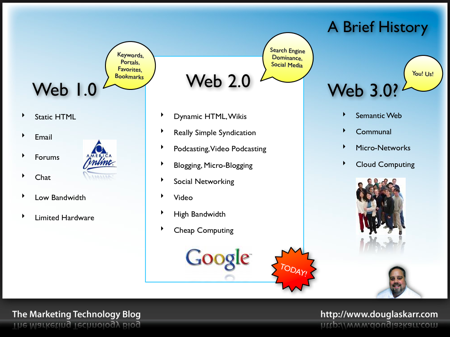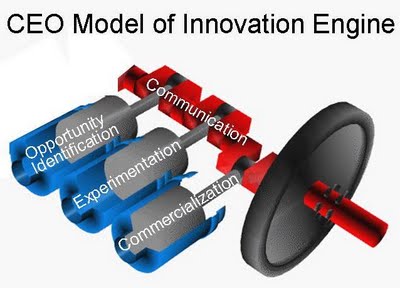And now, Web 3.0
In this post, I would like to discuss how Web 3.0 changes innovation management: by providing sensors connecting in real time to users and partners for continuous cocretion, it leads to build a specific innovation Operating System, an engine for living innovation.
There have been 2 main Internet waves:
- Web 1.0 has opened a new window to the world: in a mouse clic and a stridently modem connection, we were looking from France at american colourful textual pages such as Yahoo!, Altavista, and Lycos, navigating with Netscape mosaic, developing “one to one” communication with emails.
- Web 2.0 has matched with the acceleration of all kinds of distribution: video distribution and sharing (ugc) enabled by broadband connection, e-commerce uptake facilitated by permanent access, information distribution with new generation of search engine like Google, and the rise of exponential “many to many” exchanges linked to social networks like Facebook and Twitter.
We have entered a new stage called Web 3.0. Web 3.0 are Tim O’Reilly words, also talking about Web² as explained in Place de la toile translation:
- It encompassess semantic web, a “Web of data” that enables machines to understand the semantics, or meaning, of information on the web, inserting machine-readable metadata about pages and how they are related to each other. It creates an overlay of formated information ready to be used by computers, facilitating social intelligence. “When it does” says Tim Berners Lee “the day-to-day mechanisms of trade, bureaucracy and our daily lives will be handled by machines talking to machines. The ‘intelligent agents’ people have touted for ages will finally materialize.”
- Tim O’Reilly in Web Squared speaks of real time data, communicating objects, collective intelligence: an overflowing Web, that exploits in real time all available data rising up from ubiquitous sensors, part of them being produced by our own behaviors and digital footprints.
Ubiquity, virtureality
I see Web 3.0 from a slightly different angle, matching the previous technological outputs, semantic Web and real time data, but more human oriented: “Internet is everywhere” used to say my customers 5 years ago at focus group about IPTV. I think it’s becoming more actual everyday: we can feel the pervasive Internet in our life, it’s like a blend between virtuality and reality. This mix, or virtureality seems to me the most striking aspect of Web 3.0.
Internet is now part of all processus: not only purchasing with e-commerce or information search, but any value creation processus. These interleaving links between virtuality and reality cover a wide array of human processus:
- cultural creation with transmedia, leveraging on all digital platforms to build a storyworld traveling across various media;
- digital tools used to format the news, bloggers input, data journalism demonstrated by Wikileaks, exchanges between journalists and their readers;
- as well as the “oldest occupation in the world” like prostitution where Facebook is used as a display (How Tech Tools Transformed New York’s Sex Trade);
- digital city where “information highways” prevail on real streets, superposing new mapping as explained in Place de la toile podcast.
Bertrand Cathelat, enthusiastic sociologist of the Web, goes more in-depth in this virtureality tendency in Netexplorateur trends 2011, speaking of “a 180° turn, virtuality coming into reality”. Bertrand Cathelat says: “Following “alter web”, which aimed at escaping real world, and “alter society”, escaping in social network and virtual tribes, Web is coming to the world, like a “boomerang Internet“, bringing back virtual resource into real world in various manners”:
- crowdsourcing: konbit, manorlabs, waze, tube strikecrowdmap;
- “freenomies”: drive my car, job prize, personal branding, activism 2.0;
- superposition: augmented reality (layar façade), enriched understanding (useful progress), decoded environment (looktel), speaking objects (sticky bits), reactive (luminar, twinkle), productive objects (proverbial wallets), enriched (zugstar), commercial teaser (i-butterfly), augmented reality on glasses (Vuzix).
“The Internet is over” says Oliver Burkeman following last SXSW: “we’ve been hearing about this moment in digital history since at least 1988, when the Xerox technologist Mark Weiser coined the term “ubiquitous computing”, referring to the point at which devices and systems would become so numerous and pervasive that “technology recedes into the background of our lives”.
The future innovation engine
Innovation as a processus is impacted by Internet flow and Web 3.0 wave. Evolution from linear to interaction innovation model gave birth to open innovation, and demonstrated how knowledge circulation in short cycles is the engine of innovation: now it’s time for the engine to fire, leveraging on collaborative sparkles. The next innovation move will extend multirateral interactions and accelerate knowledge circulation through a permanent iterative cocreation phase:
- Customers, developers (thinking of market place and app store ecosystems), new players will be part of the process at every step, from the initial creation and development stages, to distribution and during product life time, extending user-led innovation approach.
- Their contribution will be in real time through digital technology, quite far from conventionl R&D…
- Permanent contribution will lead to a living innovation achieved through collaborative design, a dynamic innovation that never ends, always looking for enhancement. This looks natural with digital services, but unlikely with finished goods? You have then to think of innovation as an ecosystem, a leadership platform, able to evolve over time on various dimensions, rather than to an end product only.
What are the new rules deriving from this change of paradigm, where “innovator let go” is a strong parameter? What is the reference framework for this cooperative living innovation?
We have some trails with crowdsourcing innovation, ideas capture through tournaments, jams or hubs, early adopters community, open source cooperation for business such as OpenVBX or Invox (open source phone systems), marketplaces where others can create value, or advanced model of social CRM such as Giffgaff (“the mobile network run by you”), but real time innovation will not be contented with asynchronous punctual inputs.
This is were Web 3.0 comes on stage, bringing its intelligent agents and multilateral sensors and its stream of machines talking to machines: in a similar way, innovation has to define its sensors that will collect social contribution, formal (suggestions, feedbacks, expectations, developments, …) and tacite (usage observations, after-sales returns, …), compile data, extract meaning, and inject it automatically in the engine, working as an innovation Operating System, which designs, refines, and enriches its output in a continuous virtuous improvement cycle. Applying Tim O’Reilly claim to innovation: “building innovations that literally get better the more people use them, harnessing network effects not only to acquire users, but also to learn from them and build on their contributions”.
Defining its real-time innovation sensors and Operating System is the challenge of innovation for tomorrow.





18 Comments